How do the photographers Mary Ellen Mark and Francesca Woodman explore mental health issues in their work?
Ward 81 was the maximum-security section of the Oregon State Hospital, in which photographer Mary Ellen Mark lived with the female patients for 36 days, sharing and recordings their feelings and moods. Mark, best known for her photojournalism didn’t want to take this approach for Ward 81. She explains how her outcome from her time at Ward 81 represented a scrapbook more than a story. Mark wanted to “capture the different aspects and range of personalities” during her time there making her project.
During her time at Ward 81, Mark found that the women had very strong emotions, she explained the difference was that those in Ward 81 had more exaggerated emotions compared to those outside, “There’s no bullshit; the emotions are pure”. With Mark looking for the range of emotions within the patients, she didn’t define them down to the mental health issues with which these women suffered with, so instead of saying, “This one is schizophrenic, this one is paranoid”, she explained “this is the romantic, this is the social one”. Mark lived in Ward 81 for 36 days in which she only left twice for hamburgers which she stated was “to enhance the hospital cuisine”. Mark had met patients who had undergone electro-shock therapy and even some who had been lobotomized, she explained how the patients who were admitted to the Ward were deemed harmful to themselves and others, Mark further explained how at night, the ward “echoed with their cries”.
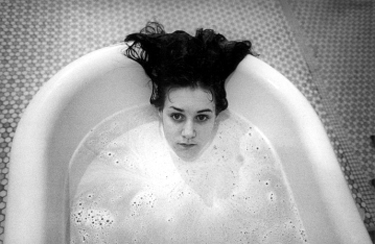
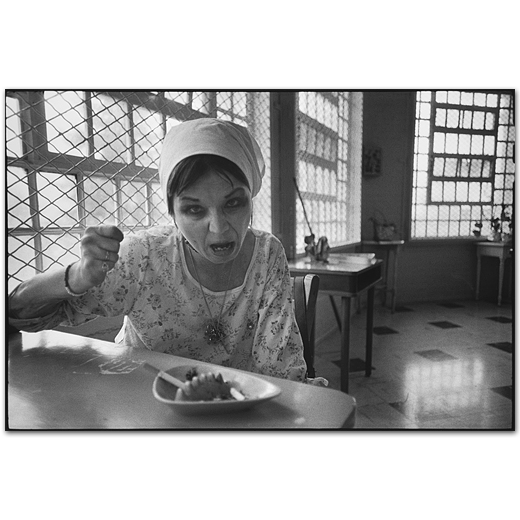
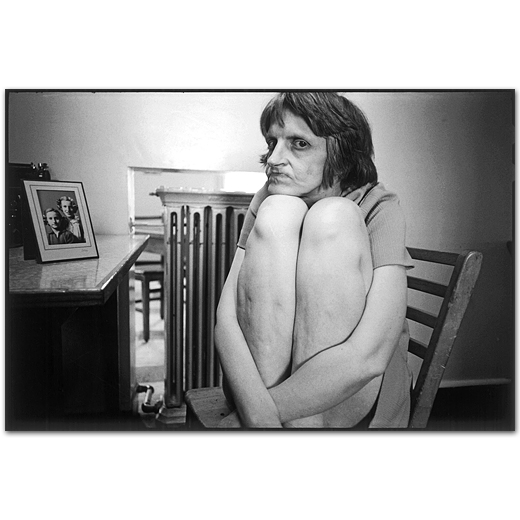
This photo of a patient who is sat next to a portrait, is explained to be and childhood portrait of a patient and her sister (who is also a patient at the hospital) which was a gift from her father which he gave to her that day.
Within the photo you can see that Marks point of focus was the patient who is sat posing in the chair, the foreground of the image is clear and sharp, as you look into the depth of the image you will see that in the middle ground (where the childhood portrait is placed) this area, whilst still being in focus this area of the photo has been blurred slightly, which highlights the relevance of the portrait which is sat on the desk. The background is blurred even more with the wall and radiator not holding much importance to the photo. The main thing that you notice visually about the photo is that it is in black white which is emotive for a person looking at the image as it has been drained of colour leaving a dark feeling, a sense of being scared and discomfort. The edge of the photo has been taken to leave the edges of the photo to have been under exposed and the middle of the photo to be more illuminated, forcing us (the viewer) to focus in in the subject.
The body language and the facial expressions of the patient in this photo shows sadness, discomfort and pain. With her body tucked into her and with her clutching her legs shows discomfort, it gives the impression that by her tucking in close to herself that she is trying to imitate human contact to comfort herself. When you investigate her face, you can see that she is showing pain, discomfort and sadness. The distance between the camera and the patient is quite small, showing that the relationship between Mark and the patients were very close, which helped allowed her to see the patients for their emotions instead of what they are labelled as in terms of behavior and mental health issues.
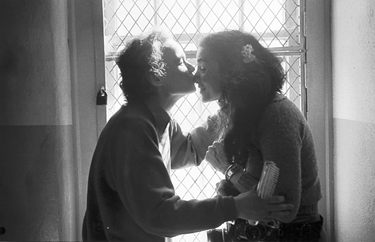
“As a joke,” says Mary Ellen Mark (above), “this patient came up and bit my nose.” 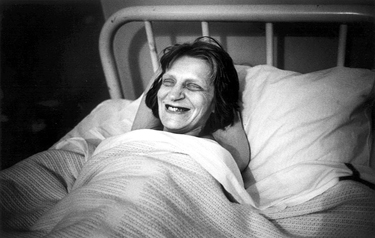
She is laughing in her bed, her limber arms wrapped about her. 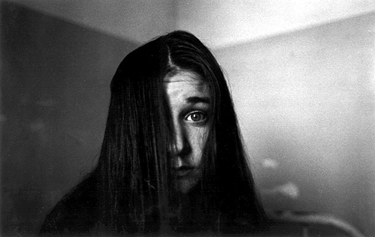
“She was feeling lost, bewildered-just as any teenager sometimes does,” says Mary Ellen Mark of the young patient above.
Francesca Woodman was an American photographer who was known to incorporate the theory and idea of mental health into her work. She used herself as a model for most of her shoots, which allowed her to keep her style of photography and the incorporation of her mental health to be more personal than it would if she had used other models more frequently. Woodman used the technique of long exposure time, in order to create a warped and disappearing into the background effect, which created the effect of having a cluttered mind. There is something otherworldly about her images, silently haunting. Woodman herself suffered with mental health issues which in turn lead to the end of her early career and short life at the age of 22 when she committed suicide. Her images to lead up to her suicide, resemble that of an unhealthy mindset, with the beginning her posing for herself with clothes on and nude, and having other people pose in this way, but towards the end, they took a drastic change, to the use of the long exposure to create that warped effect.
Woodman was working within a tradition started by important surrealists such as Man Ray and Claude Cahun.

This image of a warped and ghostly figure sat falling on the floor can have the representation of what Woodman felt like (mentally). The broken/falling to pieces house and set up can be deemed as a representation to a mindset of being broken and falling apart. This would then have a personal relationship to Woodman as she can be showing the viewers how she feels mentally.
The use of the long exposure and having the model move during this time frame creates this ghostly figure that almost disappears into the setting and background, which creates a meaning of her deleting herself from memory, like her disappearing and no one being able to recognise who this figure is, much like at the scene of her suicide where she remained unrecognisable.
The image is in black and white which evokes a sad, lonely and depressed feeling towards the picture, especially in which it is set and the setting in which it is placed. The over exposed windows allow the room to be lit up and exposed to the camera, but it also adds the feeling of the background being harsh with this vivid lighting as if there is nothing outside. Whilst the long exposure allowed the ghostly figure from the moving model blend well into the background, the broken room was captured and looked a sharp image and had defined lines which allow the viewer to see the dimensions and the depth of the room.
The distance between the figure and the camera shows that the relationship may not have been as close between the camera and the figure, or the purpose of having this distance was to show the separation and distance between Woodman’s state of mind and life and how she may have tried to keep her worries and issues far away and not tackling them.
Both photographers Mary Ellen Mark and Francesca Woodman explored mental health issues in their work that they had created, Mark through showing the personalities and real emotions and expressions of the women who were institutionalised to the maximum-security section at the Oregon state hospital and Francesca through long shutter speeds to create a ghost-like figure illusion. Whilst both artists had a different approach to the topic of mental health, with Mark (not pointing out) the mental health issues with her subjects, but just taking photos of them in their physical state there and then, and Woodman using the pictures to try to convey and underlying sense of human fragility.
They both use black and white images to create a sense of sadness and depression, which really gives the images their emotion and where the viewers can understand the topic and the general emotion without needing to understand the story behind the photo.
In both images which I have analysed they backgrounds/surrounding rooms are simple and bland, which helps draw the focus to the main and most important part to the image which in both photos are the person which can be seen. Whilst both artists include a person but at different depths which could be due to the intense or lack of relationship between the model and photographer, they both have placed the model in the same place which is just over two thirds of the way across the picture, which limits the room that they take up allowing more background space, but this use of limiting how much foreground they take up increases how much the viewer is drawn to the figure.
A clear difference that can be seen within the photographs and general photographers work is that in Mark’s Ward 81 work is that she is always up close to her models due to the trust, respect and relationship that has been made and gained, but she is always focussed on the face and body language and general actions around her and the camera. This allowed her to explore the patient’s personality and how they really acted.
But Woodman would do a range of keeping the form of the figures shown in her photos to using the long exposure settings to create the in-humane like figures and forms, in order to create that feeling of being misplaced from humanity and slowly merging onto the background. Woodman also poses models nude in some of her photo shoots, which could represent not being held down by expectations. She used the photos to represent and show her mental health through the work of her photography. In many ways it was an explanation of herself, a form of therapy and catharsis.
In conclusion Francesca Woodman uses her point of view and her representations of mental health to present in her work, by exploring these ideas of disappearing into the background and being in places where the setting is falling apart, which represents an unstable mind, and the mindset of someone with these issues. Whereas Mary Ellen Mark explores mental health by placing herself in the shoes of the women in Ward 81, but instead of the models being put into positions and movements to symbolise their mental health, Mark allows them to be free with their movements to capture the real emotions of the ladies in Ward 81. Both artists show their own representations of what they feel mental health looks like, and both share similar ideas with using black and white to interpret darkness and gloom. Woodman creates moods by altering reality and not capture humans in their state of mental health, whereas Mark uses reality to show the effects of mental health issues on people, by photographing their faces and how they act daily, the reason for this, is Mark would have been sensitive to the codes of representation, standards and ethics that documentary photographers are bound to (hence why there is an anonymity with regards to their name and condition). To be able to touch our emotions as viewers, as an audience, we must be able to connect with these codes. In the form of a book we are able to immerse ourselves in the work in a quiet and private way, but viewing the work in a gallery space the work can take a shared and communal edge.
